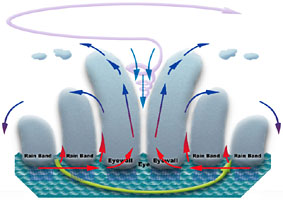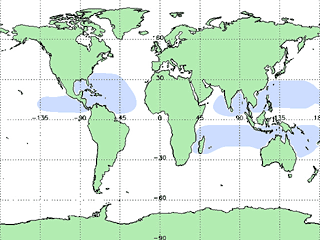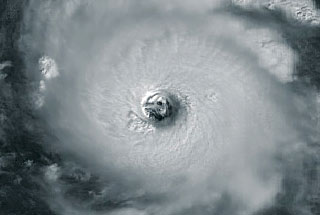
"Tropical Cyclone" (TCS)
 Tropical cyclones are regarded as a subtype of the "Mesoscale Convective
System".
Tropical cyclones are regarded as a subtype of the "Mesoscale Convective
System".
They differ from the other cloud vortex forms by having other emerge,
development and structure.
They are frontless low pressure systems with organized convection, heavy
thunderstorms and a closed surface-wind circulation around the low pressure
centre.
They are also well-known as Hurricanes or Typhoons.
The sizes of the cyclone are from 500-700 km to 1200, rare
1500km.
Its cloud top height reaches 12-15, to 16 km.
The albedo is 0.8-1.
Most tropical cyclones emerge above the sea surface within
a zone, which lies between the southern and the northern latitudes of
30°, if the water temperature is min 26.5 °C up to a depth of
40 m.
In order to cause a rotating cyclonic motion, the Coriolis Effect must
be effectively enough and it happens only starting from 5° northern
and from -5° southern latitude. Therefore the tropical cyclones are
not observed above the equator area.
An emerge of tropical cyclone is also additionally supported by the internal-tropical
convergence zone in the areas [5°, 30°] and [-5°, -30°].
It provides the rising of air masses and strong convection.
Air masses move towards the centre (convergence) in deeper
layers of a cyclone.
After rising in approx. 12 - 15 km height they flow again apart (height
divergence). This leads to the development of the strong clouds. The spiral-like
air rising is additionally increased by the heat radiation that is accompanied
with the condensation of water weapon.
The "deep convection" cumulonimbus and stratocumulus clouds are mostly
represented in the centre of the cyclone.
The tropical cyclones are described detailed in literature
and Internet.
|

